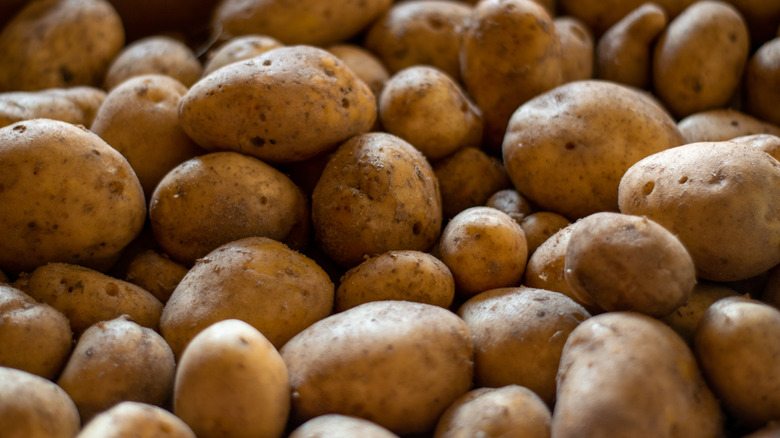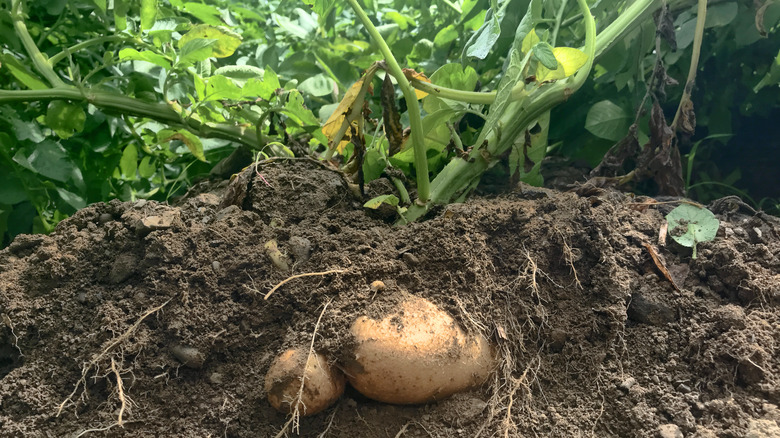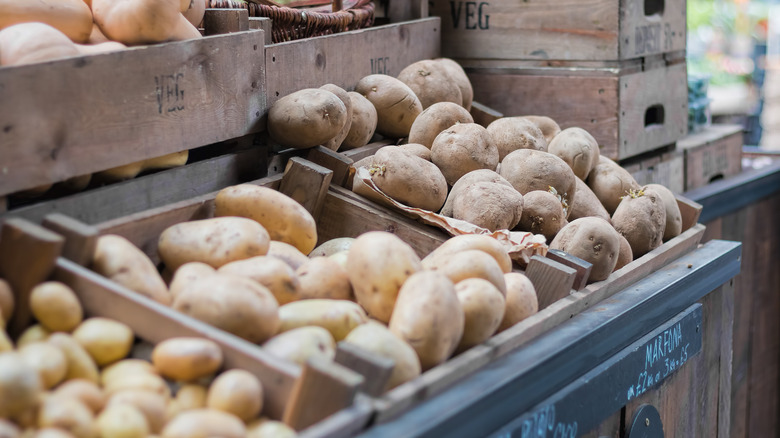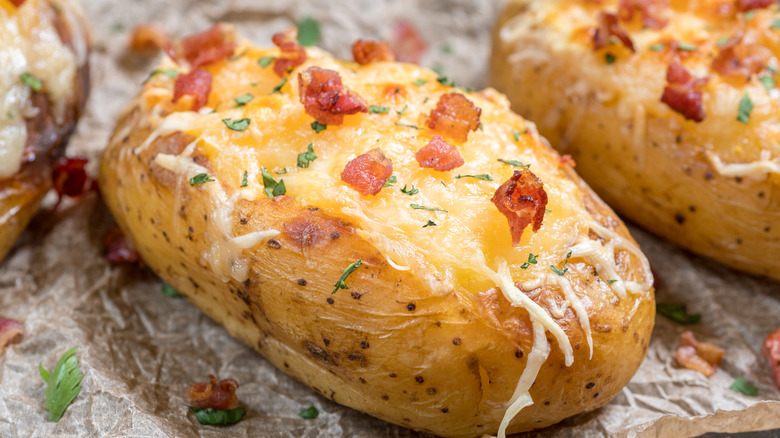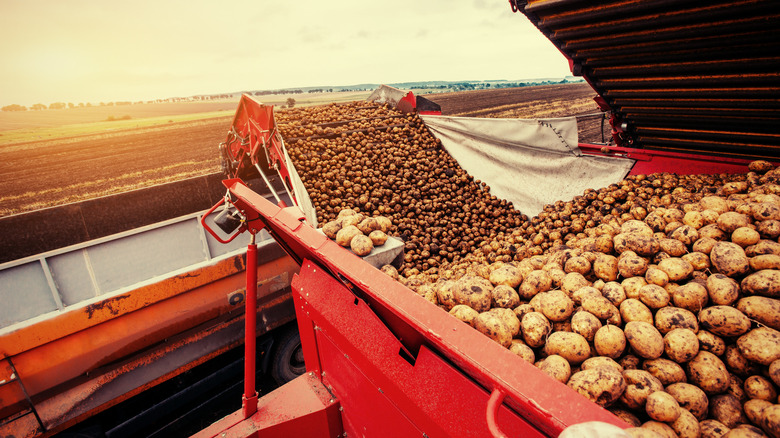Everything You Need To Know About Russet Potatoes
Potatoes have been a food staple for centuries. They are not only an affordable form of sustenance but also versatile — used to make baked potatoes, French fries, potato salads, and more — and have even inspired games like "hot potato." Many have heard of the historical Irish potato famine in 1845 when a fungus destroyed crops and led to devastating results across the country (via History.com).
But in fact the potatoes originated much earlier than this time period, in Peru, says Potato Goodness. Here, the Inca Indians were the first to cultivate the crop around 8,000 BC and potatoes didn't actually make their way to Europe until the Spanish Conquistadors overtook the country and brought back this food to the mainland in the 16th century. In fact, the Spanish influence is quite strong to this day – the word potato is linked to the Spanish term "patata" while its lighthearted nickname spud takes off from the Spanish word "espada," or the tool used to dig them out from the ground, notes Live Science.
Today, potatoes are the number-one vegetable crop in the US and the world's fourth largest food crop (after rice, wheat, and maize, says Potato Goodness) and there are more than 4,300 varieties around the world (most found in the Andes Mountains), including 180 species of wild potatoes that you can't even eat, according to Food Print. But the top dog, reigning star champion of all potatoes still remains the big, starchy russet potato belonging to the nightshade family — the same as tomatoes, eggplants, and bell peppers, says Specialty Produce.
What exactly are potatoes?
Potatoes are also known as tubers, aka "large underground storage stems," says Master Class. They come from the nightshade plant that is native to the Andes Mountains, and these plants can also make flowers and poisonous berries. Curiously enough, this doesn't apply to sweet potatoes that come from a different species, the site notes.
Unlike popular belief, potatoes are not actually root vegetables. They are the "swollen part of the stem of the perennial Solanum tuberosum," says Live Science, further noting that their distinction as tubers means they function to provide food to the leafy part of the plant.
Russet potatoes tend to be larger and have more of a long oval shape than other popular types like red, yellow, and fingerling potatoes. Russets also have brown skin and a white center that brings a high level of starch to your cooking (via Wonder How To). Since the starch level is so high in russets, they become fluffy and flaky, which is why they are the perfect kind for baked potatoes, hash browns, latkes, and even French fries (fun fact: fries were first introduced to America by President Thomas Jefferson, who served them in the White House in the early 1800s, according to Live Science).
A brief history of russet potatoes
While Peru is the place where the starchy gift of potatoes originated from centuries ago, they weren't introduced to Europe until the late 1500s and then made their way to North America in 1719, according to Food Print. But russet potatoes specifically weren't developed until 1872 when a Massachusetts farmer by the name of Luther Burbank created them through hybridization, says Specialty Produce.
After planting seeds from an early rose parent plant, he discovered that this produced a potato that was two to three times the size of the tubers he had previously seen. It was eventually named the Russet Burbank in his honor and has now become the most grown kind in the United States, particularly in the Pacific Northwest.
Idaho and Washington produce the most potatoes of any of the other states (also why they're sometimes called Idaho Potatoes), but when it comes to world production, China, India, Russia, and Ukraine are at the top of the list, says Food Print. You can generally get russets from generally any grocery store or market, and Specialty Produce notes that russet potatoes are usually available year-round — but the peak season is in the early winter through the late spring. Once you bring some home, store them in a cool, dry, and dark place and they'll keep for about a month.
How to cook russet potatoes
Since russet potatoes make up 70% of all potato sales in the US, according to Master Class, it's safe to say there are a ton of ways to cook them. Due to their tough skin and high starch content, russets soak up flavor really well and lend themselves well to baked potatoes (with a crispy skin and the inside absorbing the butter and sour cream) as well as fried dishes like French fries. In fact, it's said that 60% of all potatoes in the States are used to make French fries and chips, according to Specialty Produce.
To make the perfect baked potato, first you should clean the tuber by scrubbing it under running water and pat it dry. Then, rub olive oil and put a few dashes of salt and pepper on all sides, and finally pierce the potato a few times with a fork so it has room to vent the steam. Once ready, place on a foil-lined baking sheet for about an hour at 425 degrees Fahrenheit to cook (via The Kitchn). Once done, you can customize with your favorite toppings.
Mashed potatoes are another option where russets shine. To mash them, again you'll want to scrub and rinse off the potatoes before you do any cooking, especially if you're the kind of person that likes skins in the mix, says Delish. In a large pot, cover the potatoes with water and bring to a boil and let cook until they're completely soft (about 16-18 minutes). Once ready, use a masher to break them down and then add in a creamy mix of butter, milk, and sour cream and season to taste.
There's so many other ways to bake, air fry, and deep fry russet potatoes to get the desired dish. The possibilities are really endless!
Are potatoes actually good for you?
Potatoes at their core are very low in calories, with just about 110 calories per medium-sized spud, says Live Science – but they are high in starches and carbohydrates, which is a reason why they are best enjoyed in moderation, according to Healthline. This is especially true when it comes to how they are prepared, as frying them and adding loads of butter, sour cream, and cheese can tack on calories and lead to weight gain and diabetes if consumed in excess.
When cooked the right way (steaming is the suggested healthful way of preparing them), potatoes can be a powerhouse for nutrients and phytonutrients. Healthline notes that one serving offers 4.3 grams of protein, 36.6 grams of carbs, and 3.8 grams of fiber, plus a good portion of the daily recommended value of many nutrients. That includes 28% of vitamin C, 37% of vitamin B6, 26% potassium, 19% manganese, 12% magnesium, and 12% folate. Because of their fiber content, potatoes can also be helpful for digestion says Live Science. You'll just want to be sure to eat the skin too since that's where many of the nutrients are housed.
